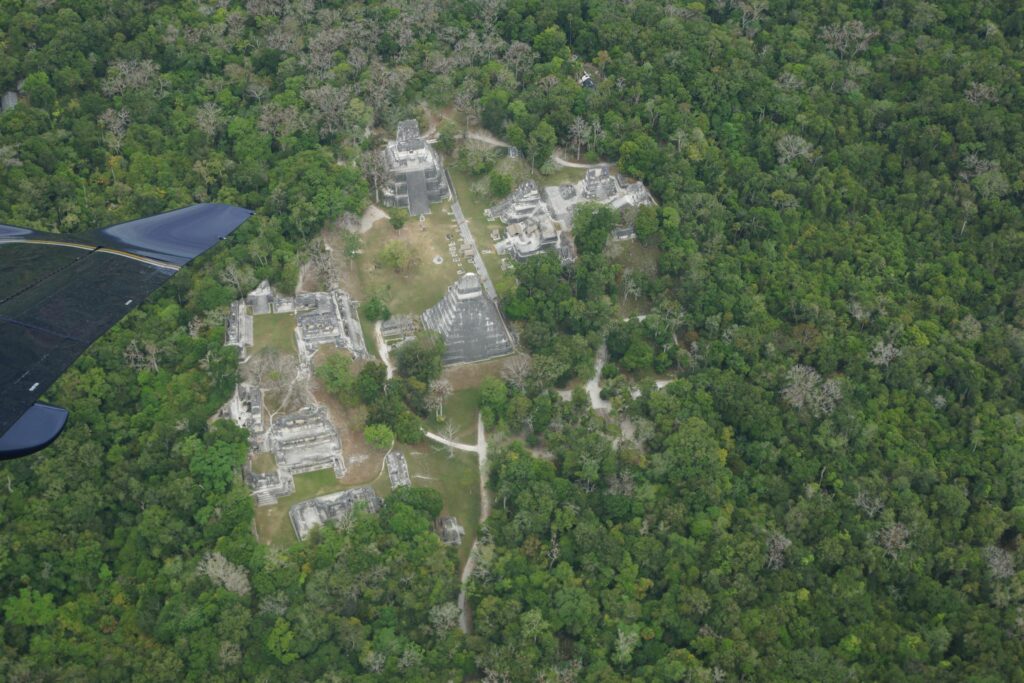Towering pyramids poke above the jungle‘s green canopy to catch the sun. Howler monkeys swing noisily through the branches of ancient trees as brightly colored parrots and toucans dart from perch to perch in a cacophony of squawks.
In the morning the elevator in the hotel is still out of order; they are working on it for the second day now. Service. The driver picks us up on time, Immigration and Security is smooth; only we have to wait for out passports for about half hour.
The flight to Flores airport is short and intensive. There are some bad weather areas the pilots have to fly around. We ask for permission for a sightseeing flight and it gets granted without any problems. Tom is really into his thing now as he flies the plane low over the ruins. Unfortunately it is pretty shaky and difficult to video tape. But it is impressive: after flying over the jungle for a hour – all of a sudden they are here.
The approach into Flores airport is also interesting. There was a Maya settlement on a small peninsula; it got leveled by the Spanish and the built their houses there. Immigration again smooth and we drive about an hour to Tikal. The landscape reminds us of Uganda; all is green and hilly – and they also grow coffee here.
At the Jaguar Inn, a very basic Inn, we have lunch, wait till all rooms are ready and take a rest. There we meet Caesar, our guide for the sunset tour. A real funny and knowledgeable fellow (litttlcaesarstravels@yahoo.com – whoever needs a good guide in Tikal) who does the sunset tour through the ruins with us. While we are entering the site, all tourists are leaving since they go back to Flores where they stay overnight. It is the more exciting place than Tikal!
The most striking feature of Tikal is its steep-sided temples, rising to heights of more than 61 meters. But Tikal is different from Chichen Itza, Uxmal and most other great Maya sites because it is deep in the jungle. Its many plazas have been cleared of trees and vines, its temples uncovered and partially restored, but as you walk from one building to another you pass beneath the dense rainforest canopy.
Tikal is set on a low hill above the surrounding swampy ground – which might be why the Maya have settled here around 700 BC. Another reason was the abundance of flint, used to make clubs, spearheads, arrowheads and knives. Fling could also be exported in exchange for other goods. Within 200 years the Maya of Tikal had begun to build stone ceremonial structures, and by 200 BC a complex of buildings stood on the site of the North Acropolis. By the middle of the Classic period, during the mid-6th century, Tikal sprawled over 30 km2 and had a population of perhaps 100‘000. Tikal‘s greatness waned around 900, part of the mysterious general collapse of lowland Maya civilization.
After almost three centuries as a Spanish colony, Guatemala won its independence in 1821. During the second half of the 20th century, it experienced a variety of military and civilian governments, as well as a 36-year guerrilla war. In 1996, the government signed a peace agreement formally ending the conflict, which had left more than 100‘000 people dead and had created, by some estimates, some 1 million refugees.
Guatemala is the most populous of the Central American countries with a GDP per capital roughly one-half that of the average for Latine America and the Caribbean. The agricultural sector accounts for about one-tenth of GDP and half the labor force; key agricultural exports include coffee, sugar, and bananas.
The distribution of income remains highly unequal with the richest decile comprising over 40% of Guatemala‘s overall consumption. More than half of the population is below the national poverty line and 15% lives in extreme poverty. Poverty among the indigenous groups, which make up about 38% of the population, averages 76% and extreme poverty rises to 28%.
Given Guatemala‘s large expatriate community in the United States, it is the top remittance recipient in Central America, with inflows serving as the primary source of foreign income equivalent to nearly two-thirds of exports.
Unfortunately there is no sunset to be seen since it was rather cloudy. So we walk back early to the Inn, take a shower before dinner and hit the sack around 21.00h. There is not much to do in the Park here and the bar closes at that time.
